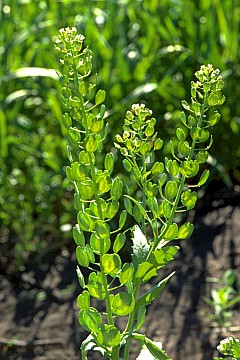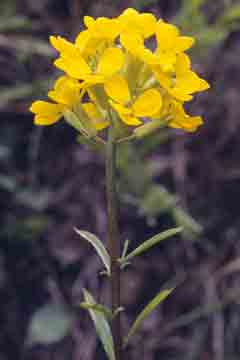
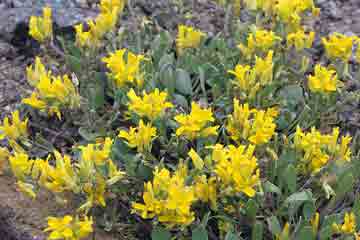
Western bladderpod, Physaria occidentalis (S. Watson) O’Kane & Al-Shehbaz (right). The western bladderpod (previously Lesquerella occidentale S. Watson) is a small, more common plant than the alpine bladderpod shown on the left. It grows on gravelly ground from mid-elevations to subalpine slopes. Spoon-shaped leaves are unique to this species and serve to identify it, as does the centrifugal growth pattern of the clusters.
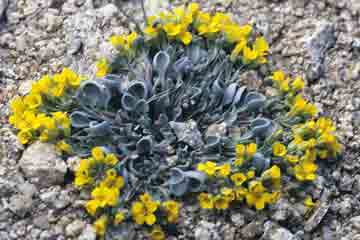
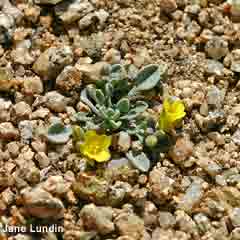
American yellow rocket, Barbarea orthoceras Ledeb. (right). Many plants in the mustard family are, like this one, edible. Given their human use it is not surprising that many have several common names, they are plants that go by many including, for this plant, winter-cress, bitter-cress, yellow cress, etc. Many edible cruciferae are imports although this one is a native species. Its leaves are edible greens with a nippy taste resembling that of the related arugula (Arugula sativa). The American yellow-rocket prefers a moist environment and is often fount growing in still water of springs, in slow-moving backwaters, etc. It may be identified by its preferred growth location, by many -lobed ladder-like leaves with broad ends, by yellow four-petaled flowers (common to the family in general), and by elongated, upright siliques. Barbarea was named for St. Barbara; its species name, orthocercas, from the Latin means "straight horn," presumably for its fruit (siliques).
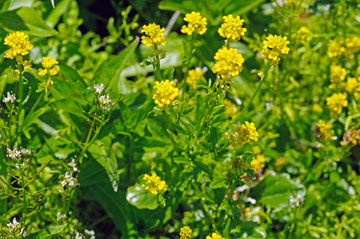
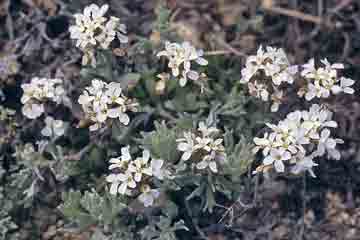
Idaho candytuft, Noccaea fendleri (A. Gray) Holub var. idahoense (Payson) F. K. Mey. (right). Two native thlaspis, formerly varieties of Thlaspi fendleri, have recently been reclassified into separate species of another genus: Noccaea montanum and Nocceaea fendleri. The latter is the plant shown here (formerly classified as Thlaspi idahoense Payson). The leaves of the former are rounder and have well developed leaf stems, whereas the leaves of the Idaho candytuft, are more lanceolate and taper to attach directly to the main stem. Our plant is found only in the mountains of central Idaho, whereas the alpine species grows in all of the western states. The name Noccaea honors Domenico Nocca (1758-1841) an Italian clergyman and botanist.

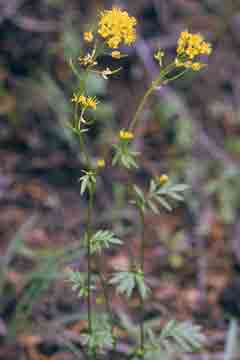
Weedy crucifers
Many crucifers in our mountains are weeds; some are Eurasian imports. Several are shown here.
Western tansy mustard, Descurainia pinnata (Walter) Britton (left). All descurainias are weeds. The one shown here is very common, growing to mid-elevations. It has clusters of small four-petaled yellow flowers, erect siliques (just forming here) and pinnate (featherlike) leaves. A relative, the common flixweed, Descurainia sophia (L.) Webb ex Prantl, is a Eurasian weed, that has spread throughout America. The flixweed can be distinguished from native species for it has bi- or tri-pinnate feathery leaves. The genus Descurainia was named for French botanist François Descurain (1658-1740).
Whitetop, Cardaria draba (L.) Desv. (right). The whitetop, (also heartpod hoary cress) has compact, flat-topped flower clusters that bloom from the outside in. It is further identified by its rather succulent serrated leaves and heart-shaped silicles (fruit). It is a ubiquitous plant, growing at least to mid-elevations, blooming from early spring through the summer, sometimes forming immense patches on disturbed ground.
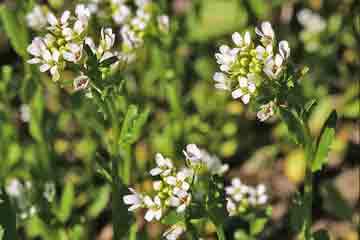
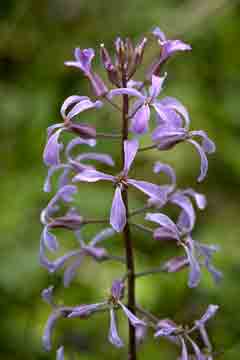
Field pennycress, Thlaspi arvense L. (right). Field pennycress grows, often in great numbers, on disturbed dry ground. It is so common a weed that most will recognize it at first glance. Its common name, “pennycress,” is derived from its disc-shaped silicles. The shepherd’s purse, Capsella bursa-pastoris (L.) Medik., is a similar Eurasian import. Not shown here, it takes its name from similar, triangular, fruiting bodies.
